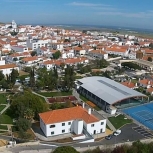
Aljustrel
In sectorial terms, the municipality registers a relative weight of Industry above the national average. The mining company Almina is consolidated in mining and in the production and sale of copper and zinc, with more than 1000 direct jobs and being the main engine of the local economy. In the primary sector (agriculture), irrigated agriculture is booming, as a result of the growth of irrigated areas, via the Alqueva Multiple Purpose Enterprise, increasing from 5 thousand hectares in 2009 to more than 20 thousand hectares today. This new reality contributes to the diversification of production, to new investments and to the emergence of a “new” agriculture and agribusiness, creating wealth and employment.
In recent years, various industries have started to settle in Aljustrel, which have diversified the local economic fabric, contributing to exports from the county having increased from around 100 million to 150 million euros, in just 4 years old. From the point of view of heritage, in addition to the rich natural heritage, it is important to highlight the unique mining heritage, both classical and industrial archeology. The geological resource that this Municipality has was and continues to be the great engine of economic activity, with a national importance, and which also translates into a very unique cultural identity (Regional Land Use Plan for the Alentejo Territory 2010). Mining activity is also an important conditioner of the landscape.
The human occupation of Aljustrel, linked to the mining activity, has existed for 5000 years (Age of Copper), as evidenced by the archaeological materials collected. However, it was during the Roman period that its occupation underwent a great increase, with the large-scale use of its mining resources. The surrounding rurality coexisted, mixing with the new traits of industrial culture, a particularly important record in times marked by the seasonality of agricultural work, when labor gave priority to this activity over mining work.
Today, agriculture and agribusiness constitute sectors with considerable economic and social relevance, with an irrigated area of 21 thousand hectares and several agro-industrial units in activity. “Tourism is an important factor in generating wealth and an activity capable of contributing to the development of depressed economies, namely through the use of endogenous resources. In the Municipality of Aljustrel, tourism develops based on synergies established between distinct areas of a traditional nature and based precisely on the region's endogenous potential”. From a heritage point of view, it would be exhausting to mention all the archaeological, built, historical, ethnographic and immaterial heritage existing in the county.
However, we must emphasize two important aspects related to material and immaterial heritage. On the one hand, make reference to the important mining heritage that still exists, both from classical and industrial archeology, with unique artefacts and installations in the mines of the Iberian Pyrite Belt and even in Europe. In the immaterial area, Aljustrel has a strong tradition in Alentejo singing, having, since the end of the 1st quarter of the 20th century, groups of singers. There are currently several groups in activity, among which the Grupo Coral do Sindicato Mineiro de Aljustrel stands out, considered the oldest choral group in activity in Portugal.
